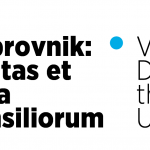Overview
Urban History Urban Topography Archival Registers Archive Historical Documents (e.g. Notarial sources; Census records; Ecclesiastical documents; Correspondence) 2D reconstruction 3D / 4D modelling and reconstruction Apps / Interfaces for data visualization Archaeological or architectural heritage
The DUCAC project – “Dubrovnik: Civitas et Acta Consiliorum. Visualizing Development of the Late Medieval Urban Fabric” – was conducted at the Institute of Art History, Zagreb, Croatia, with the support of the Croatian Science Foundation, from 2014 until 2017.
The project studied the relationships between the space-policy of the Dubrovnik government, its implementation, and the real changes in the urban fabric – changes not only to specific buildings, but to the whole urban tissue. Extensive investigation was conducted in the State Archives in Dubrovnik examining the volumes containing the deliberations of the city councils (the Major, the Minor, and the Senate) from the first half of the 15th century. These deliberations are written down in 35 volumes. They have 7,972 folia, i.e. 15,944 pages, written predominantly in Latin. The project researchers focused on topics of interest to art historians, transcribing the deliberations revealing information on the urban fabric – more precisely information about its construction, use, maintenance, as well as the management of these processes. Every deliberation that shed light on these topics was transcribed in full. Most of them are five or six handwritten lines long, but there are also those that cover several pages. In total there are 3341 deliberation transcribed that were so far available only as handwritten documents in the Archives. The deliberations are published as an OA book, but also available at the project database.
The map searchable database that was designed by N. Katičić and A. Plosnić Škarić represents a separate, and the most important result of the project. It consists of transcriptions of previously unpublished archival documents that can be found in a database in accordance with the location of the building or the space they record. Since contemporary Dubrovnik’s urban tissue differs from its appearance in the first half of the 15th century, a special map was created – representing Dubrovnik at the time – as an introduction to this database. The map is further subdivided into segments and used for web programming, providing a map-searchable database which takes three steps from the map to the text.
At the first step each segment is provided with the content, listing buildings and spaces recorded in the deliberations. During the second step, each segment opens in a separate webpage. Here the segment is magnified and dots are added to it, pointing to an exact building or space recorded in the deliberations. Each dot leads to a new webpage – that is the third step – where all the transcriptions of the deliberations regarding that building or space can be found. The symbol that was used for mapping is always a blue dot, indicating the presence of data on a deeper layer. Orientation and navigation were the next issues to be solved. The moment when a user reaches a separate page relating to a particular segment, it is crucial that he/she understands the location of that segment. Therefore, every such page contains a miniature map of the whole city in the upper right corner. The chosen segment appears on the map colored in blue. Once the user reaches a page with a magnified segment he/she can easily switch to the next segment, without having to return to the entrance page. There are two ways in which this can be done. The first is clicking on the borders of the segment, which are programmed as links leading to the adjacent segments. The other is clicking on a segment on the small map of the whole city. Each segment on that map has a link leading to the page where the chosen segment is magnified. The dots that are added to the segments were implemented using the Image Map Hotspot plugin. When touched by the cursor they show the content. They are also programmed as links leading to the pages containing the transcriptions of the deliberations. These links are activated with a simple click. The major map that serves as the entry point to the database is also provided with hot-spots. Here they reveal the content of a segment. In total 160 dots have been added to the map-searchable database, clearly demonstrating the control that the Dubrovnik government had over the city during the first half of the 15th century.
This database is meant to improve our knowledge of Dubrovnik’s urban form in the Late Middle Ages and the changes this form has undergone since. When archival investigation began, the researchers expected to find many new data, but the quantity of nearly 3,000 new deliberations exceeded expectations. Therefore, during the project, only some of these newly discovered documents could be thoroughly studied, comparing the data from the deliberations with the existing urban tissue and previously collected architectural, photographic, and archival documentation. However, this database is also intended to prompt further research. Therefore, it can be defined as a database developed by researchers for researchers.
The project also resulted with a schematic 3D model of the 15th century Dubrovnik. The purpose of the model was to represent Dubrovnik as it looked in the first half of the 15th century and to enable an understanding of the changes in the urban form that has happened since.
The creators of this map-searchable database believe that this database, as well as the 3D model schematically depicting the city of Dubrovnik in the first half of the 15th century, will prompt and facilitate further in-depth research of its urban history.
The research regarding specific buildings or topics that were conducted during the project implementation and resulted with 2D (mapping) or 3D visualisations are dully listed at the project webpage.
Project partners
Other partners
- State Archives in Dubrovnik
- Università Iuav di Venezia
